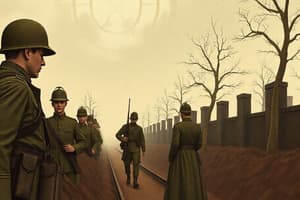Podcast
Questions and Answers
What was the impact of militarism on the tensions leading up to WWI?
What was the impact of militarism on the tensions leading up to WWI?
Militarism led nations to build large militaries, demonstrating power and increasing competition among countries.
How did alliances contribute to the outbreak of WWI?
How did alliances contribute to the outbreak of WWI?
Alliances, such as the Triple Entente and Triple Alliance, created divided loyalties and escalated conflicts when one nation was attacked.
Describe the living conditions faced by soldiers in the trenches during WWI.
Describe the living conditions faced by soldiers in the trenches during WWI.
Trench conditions were dirty, wet, and unsanitary, with constant threats from mud, lice, and diseases like trench foot.
What role did women take on during WWI as a result of conscription?
What role did women take on during WWI as a result of conscription?
What was the significance of the Battle of Vimy Ridge for Canada?
What was the significance of the Battle of Vimy Ridge for Canada?
What triggered the Halifax Explosion and what were its consequences?
What triggered the Halifax Explosion and what were its consequences?
What limitations did the Treaty of Versailles impose on the German military?
What limitations did the Treaty of Versailles impose on the German military?
Explain how nationalism contributed to the outbreak of WWI.
Explain how nationalism contributed to the outbreak of WWI.
What was the primary responsibility that Germany accepted in the War Guilt Clause?
What was the primary responsibility that Germany accepted in the War Guilt Clause?
How did the Great Depression result from the Stock Market Crash of 1929?
How did the Great Depression result from the Stock Market Crash of 1929?
What was the impact of the dust bowl on farmers during the 1930s?
What was the impact of the dust bowl on farmers during the 1930s?
What significant policy did Britain and France follow toward Hitler prior to World War II?
What significant policy did Britain and France follow toward Hitler prior to World War II?
What was the outcome of the D-Day invasion on June 6, 1944?
What was the outcome of the D-Day invasion on June 6, 1944?
What was the primary aim of the Nuremberg Trials after World War II?
What was the primary aim of the Nuremberg Trials after World War II?
What was the significance of the Just Society concept introduced by Pierre Trudeau?
What was the significance of the Just Society concept introduced by Pierre Trudeau?
How did the FLQ Crisis in 1970 affect Canada?
How did the FLQ Crisis in 1970 affect Canada?
What role did Canada play during the Rwandan genocide in 1994?
What role did Canada play during the Rwandan genocide in 1994?
What was the principle of Mutual Deterrence during the Cold War?
What was the principle of Mutual Deterrence during the Cold War?
Flashcards
Militarism
Militarism
The policy of building up strong military forces, often to intimidate other nations and show power.
Alliances
Alliances
Agreements between countries to support each other in times of war, forming alliances.
Imperialism
Imperialism
The policy of expanding a country's power and influence through colonizing other territories.
Nationalism
Nationalism
Signup and view all the flashcards
Conscription
Conscription
Signup and view all the flashcards
No-man's land
No-man's land
Signup and view all the flashcards
Treaty of Versailles
Treaty of Versailles
Signup and view all the flashcards
Reparations
Reparations
Signup and view all the flashcards
War Guilt Clause
War Guilt Clause
Signup and view all the flashcards
Flapper
Flapper
Signup and view all the flashcards
1920s and 1930s
1920s and 1930s
Signup and view all the flashcards
Suffrage
Suffrage
Signup and view all the flashcards
Great Depression
Great Depression
Signup and view all the flashcards
Dust Bowl
Dust Bowl
Signup and view all the flashcards
Holocaust
Holocaust
Signup and view all the flashcards
NATO
NATO
Signup and view all the flashcards
Mutually Assured Destruction (MAD)
Mutually Assured Destruction (MAD)
Signup and view all the flashcards
Just Society
Just Society
Signup and view all the flashcards
Study Notes
World War I Causes
- Militarism: Nations built up large militaries showcasing their power.
- Alliances: Countries formed alliances, creating opposing blocs (Triple Entente vs. Triple Alliance).
- Imperialism: Competition for colonies stirred tensions between European powers.
- Nationalism: Extreme national pride fueled tensions, particularly in the Balkans.
- Spark: Assassination of Archduke Franz Ferdinand ignited the war.
Life in the Trenches
- Conditions: Trenches were dirty, wet, and unsanitary, riddled with mud, rats, lice, and disease (e.g., trench foot).
- Emotional Toll: Constant fear, bombardments, and shell shock (PTSD) took a heavy psychological toll on soldiers.
- Food: Rations were limited and poor quality, mostly canned goods.
- No Man's Land: The area between opposing trenches was extremely dangerous.
Conscription and Women's Roles
- Conscription: Mandatory enlistment of men in the military.
- Impact on Women: Women filled jobs vacated by men, working in factories, farming, and as nurses.
Key WWI Battles
- Battle of Ypres: First use of poison gas by Germany.
- Battle of the Somme: Heavy casualties, introduction of tanks.
- Battle of Vimy Ridge: Canadian victory, significant for national identity.
- Battle of Passchendaele: Muddy, costly battle with limited gains.
Halifax Explosion
- Event: 1917 munitions ship explosion in Halifax Harbor, devastating loss of life.
- Inspiration: Inspired disaster relief and safety advancements.
Treaty of Versailles
- Reparations: Germany obligated to pay billions in damages.
- Military Restrictions: Army limited to 100,000 troops, no air force, restricted navy (battleships under 10,000 tons), demilitarized zones.
- Imperialism: Germany lost all colonies.
- War Guilt Clause: Germany held responsible for starting the war.
1920s and 1930s Trends
- Flappers: Young women challenging traditional norms.
- Prohibition: Ban on alcohol production and sales.
- Suffrage: Women's right to vote expanded.
- Lifestyles: Rise in consumerism, jazz music, technological advancements, and urban living.
- Henry Ford: Assembly line revolutionized car manufacturing.
- Residential Schools: Institutions aiming to assimilate Indigenous children, often abusive.
Industrial Revolution and Winnipeg General Strike
- Worker Demands: Better wages, shorter hours, improved working conditions.
- Factory Conditions: Factories were dangerous, overcrowded, and poorly ventilated.
Stock Market Crash of 1929
- Event: Collapse of stock prices due to speculation and overvalued shares.
- Impact: Led to the Great Depression, widespread unemployment, and economic decline.
Dust Bowl Impact on Farmers
- Impact: Severe drought and dust storms destroyed crops, causing financial ruin for farmers.
On-to-Ottawa Trek
- Details omitted.
World War II
- Allies: Britain, France, USA, USSR, and others.
- Axis: Germany, Italy, Japan.
- Appeasement: Giving in to Hitler's demands to avoid war.
- Adolf Hitler: Leader of Nazi Germany.
- Nazis: Political party leading Germany.
- Fascism: Political ideology of Italy.
- Holocaust: Systematic genocide of Jews and others by the Nazis.
- British Commonwealth Air Training Plan: Canada trained Allied pilots.
- Battles:
- Battle of Britain: Air battle, Germany's first major defeat.
- D-Day (Normandy): Allied invasion of France, vital turning point.
- Battle of Stalingrad: Major Soviet victory against Germany.
- Atomic Bomb: Dropped on Hiroshima and Nagasaki, ended war with Japan.
- Internment of Japanese Canadians: Forced relocation due to fears of espionage.
- Nuremberg Trials: Trials of Nazi war criminals.
Cold War
- Korean War: Conflict between North and South Korea, aided by UN forces.
- Cuban Missile Crisis: Tense standoff over Soviet missiles in Cuba, nuclear threat.
- NATO: Military alliance against Soviet Union.
- NORAD: Canada-US partnership for air defense.
- Mutually Assured Destruction (MAD): Preventing nuclear war by maintaining large arsenals.
- Mutual Deterrence: A doctrine of deterrence.
- Just Society: Canadian Prime Minister Pierre Trudeau's vision of upholding human rights and equality.
Ontario Human Rights Code
- Early laws protecting individuals from discrimination.
- Expanded to include protections for sexual orientation, gender identity, and disability, over time.
FLQ Crisis
- Event: Separatist group kidnapped targets.
- Outcome: War Measures Act implemented, crisis resolved.
Rwanda and Yugoslavia Conflicts
- Rwanda: Genocide targeting Tutsi.
- Yugoslavia: Breakup after communism, led to conflicts (ethnic cleansing).
- Canada's Role (both): Provided peacekeeping support and humanitarian aid.
Studying That Suits You
Use AI to generate personalized quizzes and flashcards to suit your learning preferences.




